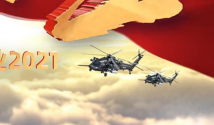You are using an out of date browser. It may not display this or other websites correctly.
You should upgrade or use an alternative browser.
You should upgrade or use an alternative browser.
Z-20 (all variants) thread
- Thread starter delft
- Start date
I wonder, could it have been possible to make the Z-20 based on the NH90 instead, it's a much more modern helicopter and AVIC has gotten license transfers from Airbus before such as the H175. Would also have prevented the insufferable american whining about the Z-20 being a black hawk copy
The Australian experience suggests China was much better off copying H-60 rather than NH90.I wonder, could it have been possible to make the Z-20 based on the NH90 instead, it's a much more modern helicopter and AVIC has gotten license transfers from Airbus before such as the H175. Would also have prevented the insufferable american whining about the Z-20 being a black hawk copy
What happened with the Australians?The Australian experience suggests China was much better off copying H-60 rather than NH90.
TerraN_EmpirE
Tyrant King
Spare parts of lack there of. Faster blade erosion, doors to narrow to support infantry as they unload. High operating cost.What happened with the Australians?
Got me more curious so I went to look and found this on the wiki.Spare parts of lack there of. Faster blade erosion, doors to narrow to support infantry as they unload. High operating cost.
"In 2010, German tabloid reported that German Army experts had concerns that the helicopter was not yet ready for the transportation of combat troops. They stated that the seats were rated for only 110 kg (240 lb), not considered enough for a fully equipped soldier. Heavy infantry weapons could not be adequately secured and the cabin floor was prone to damage, citing an anecdote of damage caused by footwear. The helicopter could land on only firm ground, with obstacles not exceeding 16 cm (6.3 in). Troops carrying full equipment could not use the rear ramp due to weight-limitations placed on it. Adding a door machine gun was not possible due to space taken by troop ingress and egress; there was also no provision for fast roping or paratroop equipment. In response, the proclaimed that this article referred to a prototype, not to the production model; the specifications for which were not even finalised at the time. The prototype evaluation and its results were described as a normal procedure in an ongoing design process.
In November 2011, the MRH90 program was placed on the Australian Department of Defence's "Projects of Concern" list. The most serious problem identified by a diagnostic review, which caused a brief grounding in 2010, is rubbing caused by the bending of a spool in the engine due to uneven cooling after shutdown. Other problems identified include failure of transmission oil cooler fans, windscreen cracking, an inertial navigation system that is slow to align, and the weakness of the cabin floor to withstand the impact of soldiers’ boots – a problem also encountered in German service.
In March 2014, it was announced that a Dutch NH90 had suffered higher than expected fuselage wear and corrosion following an extended deployment at sea; analysis by the Dutch National Aerospace Laboratory attributed the corrosion to design and assembly flaws. However, the aircraft were not grounded. In response, NHI Industries launched a corrosion prevention programme and enacted several design modifications. In December 2014, Dutch NH90 deliveries, which had been temporarily halted earlier in the year, restarted after the majority of identified points were addressed and an agreement was made by the manufacturer to bear the cost of developing modifications, repairs, and preventive measures against corrosion.
The operating cost of a NH90 HCV (High Cabin Version) was reported as being at least 242,000 SEK per hour flown, or about US$28,000, in 2018"
Yeah, seems like the Z-20 was a good choice.
The blister underneath should be a phase array for the datalink. It should be meant to stream data to a ship that also has a similar datalink. These are you usual culprits of PLAN ASW ships. The helicopter can also be a target spotter for antiship purposes with the surface search or nose radar in combination with the datalink/
This is another program that has turned out to quite the success. I went away for a few years and China has finally solved the problem of not having an adequate medium sized helicopter that could work in the transport, assault and naval roles. Back 10 years ago, we saw so many surface combatant join service with only Z-9C as possible naval helicopter option. Back then, sea hawks and NH-90 seemed to be such mouth watering options. Even now, PLAN does not have enough adequate naval helicopter of right size and capabilities for conducting ASW missions off its warships. As much as PLA LH lacked a medium to large size transport, PLAN had an even larger hole.
The story of Z-20 goes back to their purchase of S-70 pre-arms embargo. They managed to order S-70s with the latest available T700 series at the time. They found S-70 to be the perfect transport helicopter for all of their needs. Unfortunately, they could not purchase any more of it. Despite this, they worked very hard to salvage any part they can in order to keep the fleet going for 30 years with very little outside help. It was said that they scavenged the smallest knots and bolts in order to maintain the S-70 fleet. As such, they got a very good idea of the ins and outs of this series. That's probably why Z-20 looks so much like S-70. China found Russian helicopters and turboshaft engines to just not be as good as Western ones. During wenchuan earthquake, S-70 showed very good performance even after 20 years of service. It had better high altitude performance than the newer Mi-17s. Therefore, China always wanted its own Blackhawk. As with the Z-8 struggles, they lacked an appropriate engine solution.
Now, they managed to not only develop Z-20, but also have a perfect turboshaft solution. It's a weird thing for me to expect/weight for a competent Chinese turboshaft engine/helicopter option for so many years and they all suddenly become available over the space of 5 to 7 years. This also might be the first time in PLA history where the engine became available before the aircraft/helo/ship. In fact, WZ-10 is more advanced than Russian engine options like the latest VK2500 (by power to weight ratio). This allows China to build similar capability into smaller sized helicopters than Russian equivalent. WZ-10 has more power than the latest 701D engine on Blackhawk. In fact, WZ-10 gives Z-20 a lot of excessive power that can be used to carry attack options. There is a question of whether they develop an assault/attack version based on Z-20 or develop an all new 10-ton class attack helicopter like Apache. Which could then replace some of those Z-9W units.
I think with Z-20 and WZ-10, they've really turned the corner. I've already counted 8 daduis in service based on Huitong's photos and scramble orbat, so close to 100 Z-20s. Shilao's podcast also mentioned that Z-20's initial production level was limited by the ongoing Z-10 production. With Z-10 production stopping, they were finally able to mass produce Z-20s. It seems like they can currently produce 40 a year. There is probably an initial requirement of 300+ Z-20s with PLA/PLAAF along with another 50+ for PLAN. With more coming later as older helicopter start to get retired. I would guess they continue to produce Z-20s for a long time.
The story of Z-20 goes back to their purchase of S-70 pre-arms embargo. They managed to order S-70s with the latest available T700 series at the time. They found S-70 to be the perfect transport helicopter for all of their needs. Unfortunately, they could not purchase any more of it. Despite this, they worked very hard to salvage any part they can in order to keep the fleet going for 30 years with very little outside help. It was said that they scavenged the smallest knots and bolts in order to maintain the S-70 fleet. As such, they got a very good idea of the ins and outs of this series. That's probably why Z-20 looks so much like S-70. China found Russian helicopters and turboshaft engines to just not be as good as Western ones. During wenchuan earthquake, S-70 showed very good performance even after 20 years of service. It had better high altitude performance than the newer Mi-17s. Therefore, China always wanted its own Blackhawk. As with the Z-8 struggles, they lacked an appropriate engine solution.
Now, they managed to not only develop Z-20, but also have a perfect turboshaft solution. It's a weird thing for me to expect/weight for a competent Chinese turboshaft engine/helicopter option for so many years and they all suddenly become available over the space of 5 to 7 years. This also might be the first time in PLA history where the engine became available before the aircraft/helo/ship. In fact, WZ-10 is more advanced than Russian engine options like the latest VK2500 (by power to weight ratio). This allows China to build similar capability into smaller sized helicopters than Russian equivalent. WZ-10 has more power than the latest 701D engine on Blackhawk. In fact, WZ-10 gives Z-20 a lot of excessive power that can be used to carry attack options. There is a question of whether they develop an assault/attack version based on Z-20 or develop an all new 10-ton class attack helicopter like Apache. Which could then replace some of those Z-9W units.
I think with Z-20 and WZ-10, they've really turned the corner. I've already counted 8 daduis in service based on Huitong's photos and scramble orbat, so close to 100 Z-20s. Shilao's podcast also mentioned that Z-20's initial production level was limited by the ongoing Z-10 production. With Z-10 production stopping, they were finally able to mass produce Z-20s. It seems like they can currently produce 40 a year. There is probably an initial requirement of 300+ Z-20s with PLA/PLAAF along with another 50+ for PLAN. With more coming later as older helicopter start to get retired. I would guess they continue to produce Z-20s for a long time.
Shilao's podcast also mentioned that Z-20's initial production level was limited by the ongoing Z-10 production.
Why is that? Z-10 is produced by Changhe whereas Z-20 is by Harbin. They don't share the same engine.


